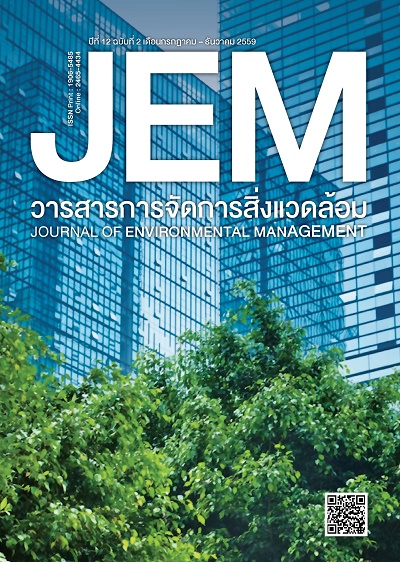การมีส่วนร่วมของประชาชนในการป้องกันปัญหาอุทกภัยในพื้นที่ลุ่มน้ำยมตอนล่าง Public Participation in Solving Flood Problems in the Lower Yom River Basin
บทคัดย่อ
การวิจัยนี้เป็นการศึกษาระดับการมีส่วนร่วมของประชาชนในการป้องกันปัญหาอุทกภัยในพื้นที่ลุ่มน้ำยมตอนล่าง โดยศึกษาในพื้นที่ 4 จังหวัดได้แก่ จังหวัดแพร่ สุโขทัย พิษณุโลก และพิจิตร โดยใช้แบบสอบถามสัมภาษณ์ประชาชนที่มีสิทธิ์เลือกตั้งจำนวน 861 คน ที่ได้มาจากการสุ่มตัวอย่างแบบบังเอิญ การวิเคราะห์ข้อมูลใช้โปรแกรม SPSS เพื่อวิเคราะห์หาค่าร้อยละ ค่าเฉลี่ย การทดสอบค่า t-testและ F-test พบว่า ประชาชนในพื้นที่ลุ่มน้ำยมส่วนใหญ่ใช้ประโยชน์จากแม่น้ำยมในการทำการเกษตรมากที่สุดคิดเป็นร้อยละ 26.36 รองลงมาได้แก่ ทำประมง คิดเป็นร้อยละ 2.44 และใช้น้ำในการอุปโภคบริโภค คิดเป็นร้อยละ 2.21 ตามลำดับในช่วงฤดูน้ำหลากจะมีประชาชนถึงร้อยละ 60.51ที่ได้รับผลกระทบจากอุทกภัย ซึ่งส่วนใหญ่จะได้รับผลกระทบด้านการเกษตรมากที่สุด คิดเป็นร้อยละ 44.36 เมื่อพิจารณาถึงระดับการมีส่วนร่วมของประชาชนในการแก้ไขปัญหาอุทกภัยในแต่ละด้านจะเห็นว่าประชาชนมีส่วนร่วมเพียงการรับรู้ข้อมูลข่าวสาร ซึ่งอยู่ในระดับปานกลาง ((x ̅=2.53)แต่ไม่พบว่าประชาชนมีส่วนร่วมในการกำหนดปัญหาการวางแผนแก้ไขปัญหา การดำเนินการ และการติดตามประเมินผล ((x ̅=0.83) โดยตำแหน่งหน้าที่ในชุมชน อาชีพหลัก และรายได้ของประชาชนที่แตกต่างกันมีผลต่อการมีส่วนร่วมของประชาชนในการจัดการปัญหาอุทกภัยอย่างมีนัยสำคัญที่ระดับ 0.05
This research studies the level of public participation in solving flood problems in the Yom river basin. The study areas comprised four provinces: Prae, Sukhothai, Phitsanulok, and Phichit. A questionnaire was used as the instrument for 861 voters using accidental sampling. For the data analysis, the SPSS program was utilized to analyze the percentage of frequency, means, t-test, and F-test. The results showed that most of the local population used the water in the Yom river for agriculture (26.36%), followed by fisheries (2.44%), and consumption (2.21%). Most of the population was affected by flooding during the rainy season (60.51%), which largely impacted agriculture at 44.36% of total flood victims. When considering public participation related to solving the identification of the flooding problem in each dimension, it was found that local people only participated through access to information at a moderate level (=2.53), while there was no public participation in defining the problem, flood solution planning, or implementation or evaluation (=0.83). The differences in the positions in the community, and the occupation and income of the population affected the public participation in flood problem management with a significance of 0.05.
เอกสารอ้างอิง
Badeeruth, C. (2013). The effectiveness of strategy to the strengthening of communities and economy in the flood zone, Ban Ta Mo village, Tambon Bang Rakam, Bang Rakam district, Phitsanulok province [In Thai: ประสิทธิผลจากยุทธศาสตร์การสร้างความเข้มแข็งของชุมชน และเศรษฐกิจ ในเขตพื้นที่น้ำท่วมชุมชนบ้านตะโม่ ตำบลบางระกำ อำเภอบางระกำ จังหวัดพิษณุโลก]. Rajabhat Journal of Sciences, Humanities and Social Sciences, 14(2), 80 – 92.
Bureau of Research, Development and Hydrology. (2011). Study, explore and Early Warning system instruction in risk lowland area of the foothills of the North, Central, Northeast and Western of Thailand with totally 15 river basins [In Thai: โครงการศึกษา สำรวจ และจัดทำระบบเตือนภัย (Early Warning) ในพื้นที่เสี่ยงภัยที่ราบเชิงเขาของพื้นที่ภาคเหนือ ภาคกลาง ภาคตะวันออกเฉียงเหนือ และภาคตะวันตก รวม 15 ลุ่มน้ำ]. Retrieved May 5, 2015, from http://webcache.googleusercontent.com/ search?q=cache:0KeAO9kcousJ:tiwrm.haii.or.th/Group3_WaterIT/03_Project_Proposal/project_proposal_edit2/DWR/word%2520-%2520file/DWR%2520proposal_edit%25202%2520-%2520project% 252005.doc+&cd=1&hl=en&ct=clnk&gl=th
Economic Intelligence Team. (2011). The great flood in 2011: Impact and the recovery trend from the survey entrepreneur. [In Thai: มหาอุทกภัย 2554 ผลกระทบและแนวโน้มการฟื้นตัว จากการสำรวจผู้ประกอบการ]. Bangkok: Bank of Thailand.
Isranews. (2015). Office of the Federal Register notified at 31 Dec 57 that total Thai population in 77 provinces surpassed 65 million with had more female than male; Bangkok population were 5.69 million while Khon Kaen Ubon and Ranong were closely equal population and the lowest population were in Samut Songkhram [In Thai: ประกาศสํานักทะเบียนกลางเปิดเผยจำนวนประชากรไทย 77 จังหวัด อย่างเป็นทางการ ณ 31 ธ.ค.57 ยอดรวมทะลุ 65 ล้าน เพศหญิงมากกว่าชาย กรุงเทพฯ 5.69 ล้าน อุบลฯ ขอนแก่น สูสี ระนอง สมุทรสงคราม น้อยสุด]. Retrieved May 5, 2015, from http://www.isranews.org/isra-news/ item/36908-eB8%B2.html
Jarusung, W. (2000). People's Participation in Conservation and Protection of Huay Kha Khaeng Wildlife Sanctuary. Master’s Thesis (Psychology), the graduate school, Kasetsart University.
Pengsakul, K. (2008). The participation of citizens in water resources management: A case study of the Palian canal watershed area, Trang. [In Thai: การมีส่วนร่วมของประชาชนในการบริหารจัดการทรัพยากรน้ำ: ศึกษากรณีลุ่มน้ำสาขาคลองปะเหลียน จังหวัดตรัง]. Final research report, Water Resource Regional Office 8, Department of Water Resources, Ministry of Natural Resources and Environment.
Pintamul, D. (2012). Municipal Solid Waste Management by People’s Participation of Bansok Sub-district Administration Organization, Lomsak District, Phetchabun Province. Bachelor’s research project (Public and Enterprise Management), Phetchabun Rajabhat University.
Pormthong, W. (2008). Factors of Decision Making on New Theory Farming Practices by Farmers in North-eastern Region of Thailand. Final research report, Rajamangala University of Technology Thanyaburi, Pathum Thanee.
Sathien, K. (2005). The study of tripartite participation pattern in landfill project, Phitsanulok municipality. Master’s Thesis (Natural resources and environmental management), Faculty of Agriculture, Natural resources and Environment, Nareasuan University.
Sribaueiam, K. (2002). Guidelines for strengthening participatory democracy based on the Constitution of Thailand BE 2540: Problems obstacle and solutions [In Thai: แนวทางการเสริมสร้างประชาธิปไตยแบบมีส่วนร่วมตามรัฐธรรมนูญแห่งราชอาณาจักรไทย พ.ศ.2540: ปัญหา อุปสรรค และทางออก]. Bangkok: Prajadhipok's Institute.
Sunthornnan, P. (2007). Factors affecting of people participation for practise defence flood problem in Thevarat organization, Chaiyo district, Angthong province. Master’s Thesis (Local Government), College of Local Administration, Khon Kaen University.
Suwannaka, S. (2009). Influence factors of public participation in Talai mountain community forest development and conservation of Talai mountains, Yai Am District, Chanthaburi. Master’s Thesis (Social Sciences for Development), Rambhaibarni Rajabhat University.
[UNCCD] United Nations Convention to Combat Desertification in Those Countries Experiencing Serious Drought. (2012). Report of drought situation in Thailand, No. 2/2012 [In Thai: รายงานสถานการณ์ความแห้งแล้งในประเทศไทย ครั้งที่ 2/2555]. Bangkok: Land Development Department.
William, W. (1976). Participation management: Concept theory and implementation. Atlanta: Georgia University.
Wacharapasakorn, S. (2013). Flood management and community's participation: A case study of Nukkeelalamtong Village, Saphansoong District, Bangkok. Master’s Thesis (Environmental management), School of Social and Environmental Development, National Institute of Development Administration.
Yamane, T. (1967). Statistics: An Introductory Analysis. [2nd edition]. New York: Harper and Row.



